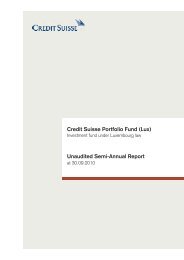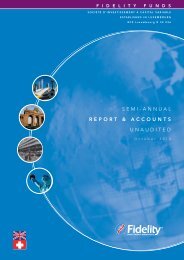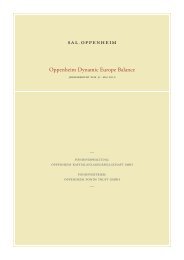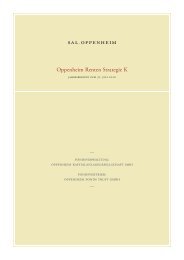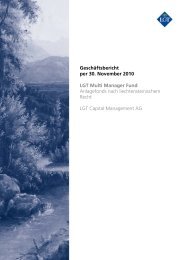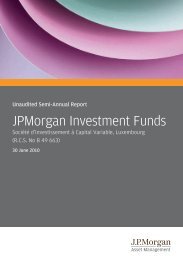Verkaufsprospekt
Verkaufsprospekt
Verkaufsprospekt
Sie wollen auch ein ePaper? Erhöhen Sie die Reichweite Ihrer Titel.
YUMPU macht aus Druck-PDFs automatisch weboptimierte ePaper, die Google liebt.
are structured in a way that enables the senior bond<br />
classes and mezzanine classes to receive investmentgrade<br />
credit ratings; credit risk is shifted to the most<br />
junior class of securities. If any defaults occur in the<br />
assets backing a CDO, the senior bond classes are first<br />
in line to receive principal and interest payments, followed<br />
by the mezzanine classes and finally by the lowest<br />
rated (or non-rated) class, which is known as the<br />
equity tranche. The Sub-Fund will invest in the rated or<br />
equity tranches of CDOs and will not be leveraged as<br />
result of such investments.<br />
A CDS is a FDI which operates to mitigate credit risk.<br />
The protection buyer purchases protection from the<br />
protection seller for losses that might be incurred as a<br />
result of a default or other credit event in relation to an<br />
underlying security. The protection buyer pays a premium<br />
for the protection and the protection seller agrees<br />
to make a payment to compensate the protection buyer<br />
for losses incurred upon the occurrence of any one of a<br />
number of possible specified credit events, as set out in<br />
the CDS agreement. In relation to the use of CDSs the<br />
Sub-Fund may be a protection buyer and / or a protection<br />
seller.<br />
A CLN is a security that pays a fixed or floating coupon<br />
during the life of the note (the coupon is linked to the<br />
performance of a reference asset, typically bonds) and<br />
which allows the issuer to transfer a specific credit risk<br />
to an investor. At maturity, the investor receives the par<br />
value of the underlying security unless the referenced<br />
credit defaults or declares bankruptcy, in which case<br />
the investor receives an amount equal to the recovery<br />
rate.<br />
The Fund may also engage in forward foreign exchange<br />
contracts for hedging purposes, to alter the currency<br />
exposure of the underlying assets, in accordance with<br />
the limits set out by the Central Bank. The Sub-Fund<br />
may also hedge currency exchange risk by entering into<br />
forward, futures and currency swap contracts and purchasing<br />
and selling put or call options on foreign currency<br />
and on foreign currency futures contracts within<br />
the limits set out by the Central Bank. Because currency<br />
positions held by the Sub-Fund may not correspond<br />
with the asset position held, the performance<br />
may be strongly influenced by movements in the FX<br />
rates.<br />
It is expected that any leverage that arises as a result of<br />
engaging in forward foreign exchange contracts, forward,<br />
futures and swap currency contracts, call options<br />
on foreign currency or foreign currency futures contracts<br />
for hedging purposes will be minimal.<br />
The performance of the Sub-Fund’s portfolio of investments<br />
will be measured against a blended index of 60%<br />
of the MSCI World Daily Total Return Net Index (the<br />
"MSCI Index") and 40% of the Citigroup World Broad<br />
Investment Grade (non-MBS) Index (the "Citigroup<br />
Index"). The MSCI Index is a free float-adjusted market<br />
capitalisation index that is designed to measure global<br />
developed market equity performance. As of 27 May,<br />
2010 the MSCI Index consisted of the following 24<br />
developed market country indices: Australia, Austria,<br />
Belgium, Canada, Denmark, Finland, France, Germany,<br />
Greece, Hong Kong, Ireland, Israel, Italy, Japan, Netherlands,<br />
New Zealand, Norway, Portugal, Singapore,<br />
Spain, Sweden, Switzerland, the United Kingdom, and<br />
the United States. The Citigroup Index is a market-<br />
PineBridge Emerging Europe Equity Fund<br />
capitalisation-weighted benchmark that tracks the performance<br />
of government or government-sponsored and<br />
corporate investment-grade debt. The index is composed<br />
of debt with fixed-rate, no zero coupons and<br />
maturities of one year or longer excluding any mortgage-backed<br />
asset class.<br />
The Investment Managers may consider that, where the<br />
Sub-Fund's portfolio make up is different to that of the<br />
referenced index, it is necessary or desirable to replicate<br />
the currency exposure of the index and therefore<br />
the Investment Managers are entitled to alter the currency<br />
exposure characteristics of certain of the assets<br />
held within the Sub-Fund through the use of forward<br />
and futures currency contracts so that, whilst its own<br />
determination of portfolio make up may be reflected in<br />
the actual portfolio make up, the currency exposure can<br />
reflect that of the index.<br />
The Investment Managers are however, entitled at any<br />
time to change one or both of the indices where, for<br />
reasons outside the Investment Managers’ control, the<br />
index has been replaced by another index or where<br />
another index may reasonably be considered by the<br />
Investment Managers to have become the industry<br />
standard for the relevant exposure. Unitholders will be<br />
advised of any change in the indices in the next annual<br />
or half-yearly report of the Sub-Fund.<br />
Any changes to the investment objective of the Sub-<br />
Fund and any material changes to the investment policy<br />
may not be made without the prior written approval on<br />
the basis of a majority of votes cast at a general meeting<br />
of Unitholders of the Sub-Fund. Any such changes<br />
may not be made without the approval of the Central<br />
Bank. In the event of a change in investment objective<br />
and / or a change to the investment policy, a reasonable<br />
notification period will be provided by the Manager<br />
to enable Unitholders to redeem their Units prior to<br />
implementation of such change.<br />
The Sub-Fund will be managed so as to be fully invested,<br />
other than during periods where the Investment<br />
Managers believe that a larger cash position is warranted.<br />
The Sub-Fund’s investments are subject to the investment<br />
restrictions as set out in the section of the Prospectus<br />
headed "Investment Restrictions".<br />
No assurance can be given that the Sub-Fund's investment<br />
objective will be achieved.<br />
The use of FDI may create an exposure risk, however,<br />
any exposure arising as a result of the use of FDI's will<br />
not exceed the Net Asset Value of the Sub-Fund (i.e.<br />
the Sub-Fund will not be leveraged in excess of 100%<br />
of its Net Asset Value).<br />
The Manager will employ a risk management process<br />
which will enable it to accurately measure, monitor and<br />
manage the risks attached to financial derivative positions<br />
and details of this process have been provided to<br />
the Central Bank. The Manager will not utilise FDI<br />
which have not been included in the risk management<br />
process until such time as a revised risk management<br />
process has been filed with the Central Bank.<br />
The Manager will, on request, provide supplementary<br />
information to Unitholders relating to the risk manage-<br />
| 68



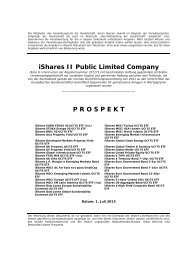
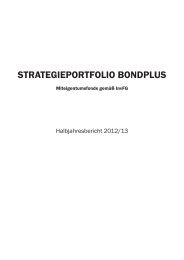

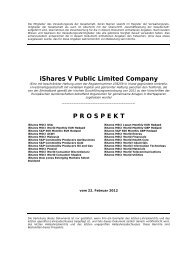
![Prospectus Simplifié daté de [Mars] 2005](https://img.yumpu.com/18875582/1/190x245/prospectus-simplifie-date-de-mars-2005.jpg?quality=85)

